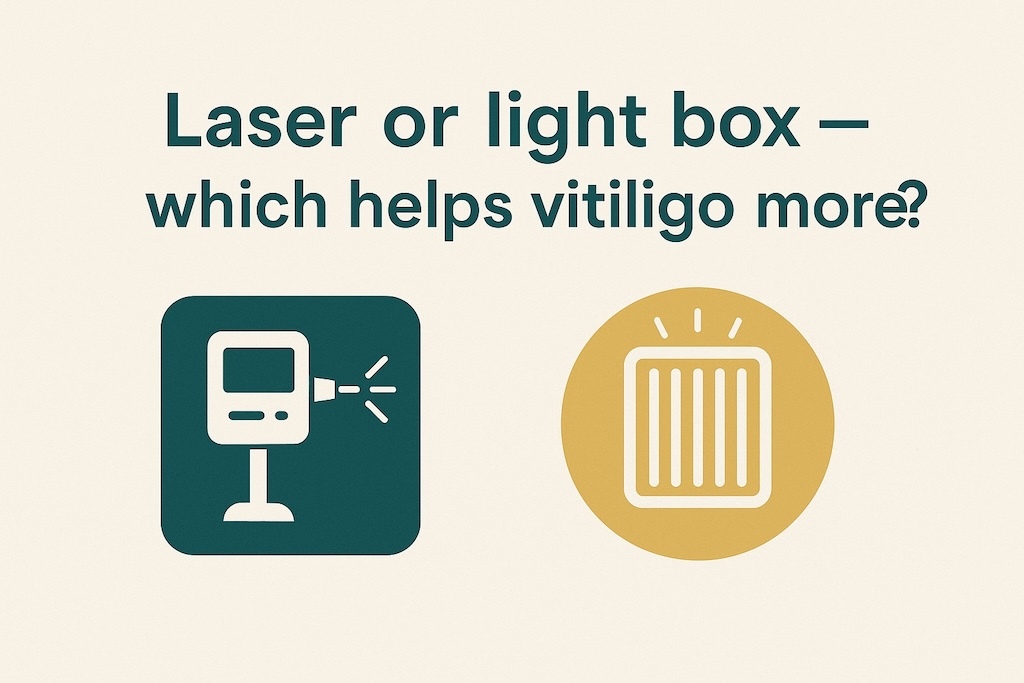Our work is entirely funded by private donations – we receive no money from government. Your money will help us continue funding research into vitiligo and supporting people affected by the condition.
FAQ
What's better: laser or phototherapy?
Laser therapy is actually a type of phototherapy. Both rely on light to trigger changes in the skin, but they work differently.
Phototherapy usually means a narrow-band UV (NB-UVB) light box that treats larger areas at once. Laser therapy, on the other hand, uses a highly focused beam to treat small patches with more accuracy and sometimes deeper reach.
In short: all laser is phototherapy — but not all phototherapy is laser.
Laser or light box?
Both can help vitiligo, but they’re used a little differently.
- Laser (excimer 308 nm): Think of it like a spotlight. It hits only the white patches you want to treat, leaving the rest of the skin alone. Sessions are quick and targeted, but since the beam is small, it works best if you only have a few spots. It can also get pricey if you need many sessions.
- Phototherapy (NB-UVB light box): This is more like sunshine for your whole body. It treats larger areas at once, which is useful if vitiligo is more widespread. It usually needs more sessions over a longer period, but it’s often more affordable per treatment and easier if you have many patches.
Let'd dig in a little deeper:
Laser Treatment
Advantages:
- Delivers targeted light to specific areas, making it ideal for localized vitiligo.
- May induce repigmentation more rapidly and require fewer sessions compared to some other phototherapy approaches.
- Minimizes broad UV exposure, potentially reducing long-term risks
Considerations:
- Typically more expensive than conventional phototherapy methods.
- Most practical for treating smaller body areas.
- May have limited availability depending on clinical resources.
Light Box
Advantages:
- Widely regarded as safe and effective for larger surface areas of vitiligo.
- Generally more accessible and less costly.
- Offers consistent efficacy, especially for widespread or generalized vitiligo.
Considerations:
- Requires more frequent treatments, often 2-3 times per week for optimal results.
- Results may be slower to appear compared to laser therapy
Effectiveness Comparison
Both laser therapy and traditional phototherapy have proven to work well for restoring skin color in people with vitiligo. Recent studies show that, for many individuals, excimer laser treatment can be just as effective as narrow-band UVB (NB-UVB) phototherapy, meaning both options can help bring back pigment in white patches. In some cases, laser treatment may bring results a little faster, especially for smaller, stubborn spots, but overall, both treatments are solid choices.
Choosing Between Laser and Phototherapy
The decision between laser therapy and other phototherapy forms depends on specific clinical factors:
- Extent of vitiligo: Phototherapy may be preferred for widespread vitiligo, while laser treatment is often better for localized areas.
- Location of lesions: Laser treatment may be more suitable for hard-to-reach areas.
- Skin type: Patients with darker skin tones may respond better to phototherapy.
- Availability and cost: Phototherapy is generally more accessible and less expensive.
So which one wins?
Neither is “better” for everyone. Laser is precise and fast for small patches; phototherapy is practical for bigger or spreading cases. Some doctors even use both, depending on the situation.
In the end, the best choice depends on how much skin is involved, where the patches are, your skin type, and what’s available nearby. The important thing: both have proven results, and both are safe when supervised by a dermatologist.
Suggested reading
- Vitiligo Patient Journey Map
- Phototherapy: How Long Does the Color Stay?
- The Real Price Tag of Treating Vitiligo (2025 edition)

FAQOther Questions
- Who is prone to vitiligo?
Vitiligo can affect anyone, regardless of gender, age, or race. Vitiligo prevalence is between 0.76% and 1.11% of the U.S. population, including around 40% of those with the con...
- How can I cure vitiligo?
Currently, there is no cure for vitiligo. However, many treatments can help manage the condition by restoring skin pigmentation, halting the progression of depigmentation, and i...
- How smoking affects vitiligo?
Smoking is a common habit linked to numerous health risks, affecting multiple body systems and increasing various disease risks, including respiratory and cardiovascular issues....
Though it is not always easy to treat vitiligo, there is much to be gained by clearly understanding the diagnosis, the future implications, treatment options and their outcomes.
Many people deal with vitiligo while remaining in the public eye, maintaining a positive outlook, and having a successful career.
Copyright (C) Bodolóczki JúliaBy taking a little time to fill in the anonymous questionnaire, you can help researchers better understand and fight vitiligo.